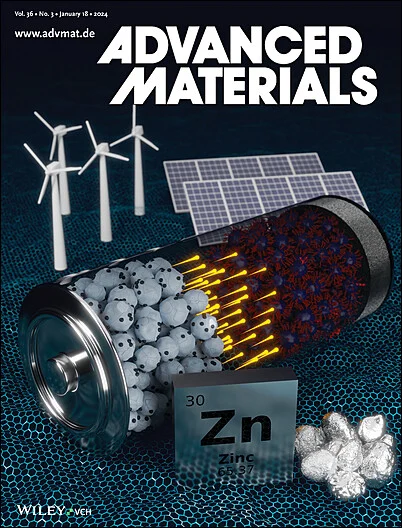微环境调节解锁高性能准固态电池用聚醚电解质中的高Li +导电
IF 26.8
1区 材料科学
Q1 CHEMISTRY, MULTIDISCIPLINARY
引用次数: 0
摘要
聚醚电解质(PEs)在高性能锂金属电池(lmb)方面引起了重大的研究和工业兴趣。然而,传统的pe受到低锂离子(Li+)导电性的限制,这主要是由于Li+ -聚合物的强相互作用(即Li+ -氧配位)。目前的聚合物分子结构修饰方法在很大程度上受到特定聚合物固有的分子结构约束和所需结构工程过程的复杂性的挑战。本文提出了一种新颖而直接的策略,通过在原位聚合过程中引入具有弱刘易斯酸度的Ge4+位点来调节PEs的微环境,从而减少Li+ -聚合物相互作用,增加自由Li+浓度,并引入离子通道。通过这种方式,微环境调节PE在25°C时具有1.83 mS cm−1的高离子电导率,并实现了0.8的Li+转移数。值得注意的是,电解质在Li||Li对称电池中表现出非凡的循环稳定性,超过2000小时,在长时间循环中表现出无枝晶的锂金属沉积。此外,组装的Li||LiFePO4电池在5℃下长期稳定2190次后,获得了令人印象深刻的92.1%和≈100%的库仑效率。这项工作为通过微环境调节设计高性能lmb聚合物电解质提供了新的见解。本文章由计算机程序翻译,如有差异,请以英文原文为准。
Microenvironment Regulation Unlocks High Li⁺ Conduction in Polyether Electrolytes for High‐Performance Quasi‐Solid‐State Batteries
Polyether electrolytes (PEs) have attracted significant research and industrial interest for high‐performance lithium metal batteries (LMBs). However, traditional PEs are limited by their low lithium‐ion (Li+ ) conductivity primary due to strong Li⁺–polymer interactions (i.e. Li+ ‐oxygen coordination). Current approaches of modifying polymer molecular structures are largely challenged by the inherent molecular structural constraints of specific polymers and the complexity of the required structural engineering processes. Herein, a novel and straightforward strategy i proposed to reduce the Li+ −polymer interaction, increase free‐Li+ concentration, and introduce ion‐channels by regulating the microenvironment of PEs through introducing Ge4+ sites with weak Lewis acidity during in situ polymerization. In this way, the microenvironment regulates PE with a high ionic conductivity of 1.83 mS cm−1 at 25 °C and a Li+ transference number of 0.8 is achieved. Remarkably, the electrolyte exhibits extraordinary cycling stability in Li||Li symmetric cells for over 2000 h, demonstrating dendrite‐free Li metal deposition during prolonged cycling. Moreover, the assembled Li||LiFePO4 cells achieve an impressive capacity retention of 92.1% and ≈100% Coulombic efficiency after a long‐term stability of 2190 cycles at 5 C. This work provides new insight into the design of polymer electrolytes for high‐performance LMBs through microenvironment regulation.
求助全文
通过发布文献求助,成功后即可免费获取论文全文。
去求助
来源期刊

Advanced Materials
工程技术-材料科学:综合
CiteScore
43.00
自引率
4.10%
发文量
2182
审稿时长
2 months
期刊介绍:
Advanced Materials, one of the world's most prestigious journals and the foundation of the Advanced portfolio, is the home of choice for best-in-class materials science for more than 30 years. Following this fast-growing and interdisciplinary field, we are considering and publishing the most important discoveries on any and all materials from materials scientists, chemists, physicists, engineers as well as health and life scientists and bringing you the latest results and trends in modern materials-related research every week.
 求助内容:
求助内容: 应助结果提醒方式:
应助结果提醒方式:


